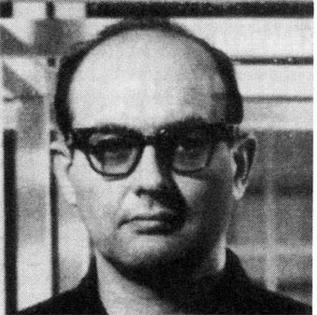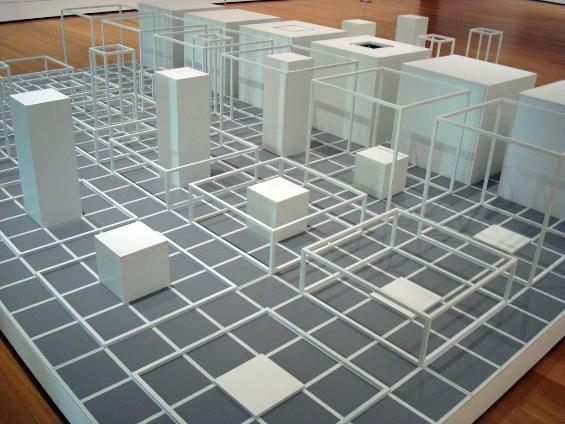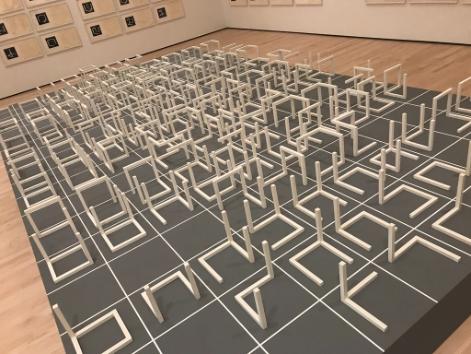Sol LeWitt was an influential American artist whose work helped define both MinimalismMinimalism is an art movement that emerged in the late 1950s and early 1960s, primarily in the United States. It is characterized by its use of simple geometric forms, clean lines, and a focus on the materiality of the work itself. Minimalist art emphasizes simplicity and seeks to strip away any unnecessary elements to reveal the essence of the artwork. More and Conceptual ArtConceptual Art emerged in the 1960s as a movement that emphasized ideas and concepts over traditional aesthetic and material concerns. The movement challenges the traditional notion that the artwork must be a physical object, focusing instead on the intellectual engagement of the viewer. Sol Lewitt, Four-Sided Pyramid, 1999 Origins and Development Conceptual Art developed as artists began to question the More. Known for his geometric forms, wall drawings, and structures, LeWitt’s work emphasized ideas and concepts over the finished product, making him a central figure in 20th-century art.

Early Life and Career
Sol LeWitt was born on September 9, 1928, in Hartford, Connecticut. He studied at Syracuse University and served in the U.S. Army during the Korean War. After moving to New York City, LeWitt worked as a graphic designer and later at the Museum of Modern Art, where he was influenced by the burgeoning minimalist and conceptual artConceptual Art emerged in the 1960s as a movement that emphasized ideas and concepts over traditional aesthetic and material concerns. The movement challenges the traditional notion that the artwork must be a physical object, focusing instead on the intellectual engagement of the viewer. Sol Lewitt, Four-Sided Pyramid, 1999 Origins and Development Conceptual Art developed as artists began to question the More movements.

Artistic Style
LeWitt’s style is characterized by:
- Geometric Forms: He used simple shapes like squares, cubes, and lines to create complex compositions.
- Wall Drawings: LeWitt is famous for his large-scale wall drawings, which often consist of intricate patterns and grids.
- Conceptual Approach: His work focused on the idea or concept behind the art, rather than the execution, making the creative process an essential part of the artwork.

Major Works
- “Serial Project No. 1 (ABCD)” (1966): This work exemplifies LeWitt’s interest in systematic structures, consisting of a series of cubes arranged in a grid.
- “Wall DrawingDrawing is a foundational art form that involves creating images on a surface, typically paper, using tools such as pencils, pens, and charcoal. It is a versatile medium that allows artists to express ideas, emotions, and stories through lines, shapes, and shading. Historical Background • Prehistoric Beginnings: The earliest known drawings date back to prehistoric times, with cave drawings found More #1” (1968): The first of his many wall drawings, this piece sets the foundation for his exploration of instruction-based art.
- “Four-Sided Pyramid” (1999): A large, outdoor sculptureSculpture refers to a three-dimensional art form created by shaping or combining materials. Sculptors use various techniques to carve, model, cast, or construct their works, resulting in pieces that can be viewed from multiple angles. History and Origin Sculpture has a long history, dating back to prehistoric times. Early humans carved figures from stone, bone, and wood. These early sculptures More that uses simple geometric shapes to create a visually complex structure.
- “Incomplete Open Cubes” (1974): A series of structures that explore the permutations of an open cube, emphasizing the concept over the material form.

Philosophical Influences
LeWitt’s work was deeply influenced by his belief in the primacy of the idea in art. He argued that the concept behind a work should take precedence over its physical execution, a principle that became a cornerstone of Conceptual ArtConceptual Art emerged in the 1960s as a movement that emphasized ideas and concepts over traditional aesthetic and material concerns. The movement challenges the traditional notion that the artwork must be a physical object, focusing instead on the intellectual engagement of the viewer. Sol Lewitt, Four-Sided Pyramid, 1999 Origins and Development Conceptual Art developed as artists began to question the More.
- Conceptual ArtConceptual Art emerged in the 1960s as a movement that emphasized ideas and concepts over traditional aesthetic and material concerns. The movement challenges the traditional notion that the artwork must be a physical object, focusing instead on the intellectual engagement of the viewer. Sol Lewitt, Four-Sided Pyramid, 1999 Origins and Development Conceptual Art developed as artists began to question the More: LeWitt’s focus on the idea as the most important aspect of art led to his development of instruction-based works, where the artist provides a set of guidelines for others to follow.
- MinimalismMinimalism is an art movement that emerged in the late 1950s and early 1960s, primarily in the United States. It is characterized by its use of simple geometric forms, clean lines, and a focus on the materiality of the work itself. Minimalist art emphasizes simplicity and seeks to strip away any unnecessary elements to reveal the essence of the artwork. More: His use of simple geometric forms and systematic compositions aligns with minimalist principles, emphasizing simplicity and clarity.

Influence and Legacy
Sol LeWitt’s impact on modern art is profound. His innovative approach to art-making has influenced a wide range of contemporary artists.
- Conceptual ArtConceptual Art emerged in the 1960s as a movement that emphasized ideas and concepts over traditional aesthetic and material concerns. The movement challenges the traditional notion that the artwork must be a physical object, focusing instead on the intellectual engagement of the viewer. Sol Lewitt, Four-Sided Pyramid, 1999 Origins and Development Conceptual Art developed as artists began to question the More: LeWitt is often credited with helping to establish Conceptual ArtConceptual Art emerged in the 1960s as a movement that emphasized ideas and concepts over traditional aesthetic and material concerns. The movement challenges the traditional notion that the artwork must be a physical object, focusing instead on the intellectual engagement of the viewer. Sol Lewitt, Four-Sided Pyramid, 1999 Origins and Development Conceptual Art developed as artists began to question the More, focusing on the ideas behind the work rather than its aesthetic qualities.
- Public Art: His large-scale wall drawings and sculptures have become landmarks in public and institutional spaces worldwide.

Techniques and Materials
LeWitt employed a variety of techniques and materials to achieve his distinctive style.
- Instruction-Based Art: Many of LeWitt’s works are created by following specific instructions provided by the artist, allowing for different individuals to execute the work.
- Wall Drawings: These large-scale pieces are created directly on walls, often using simple tools like pencils, inkInk, a liquid or paste used for writing, drawing, and printing, has played a crucial role in communication and artistic expression throughout history. Made from various pigments and dyes, ink allows for the transfer of text and images onto surfaces such as paper, fabric, and other materials. Types of Ink There are several types of ink, each serving different purposes More, and paint.
- Modular Structures: LeWitt used modular forms such as cubes and grids, often fabricated from industrial materials like metal and concrete.
Major Exhibitions and Collections
LeWitt’s works have been featured in numerous major exhibitions and are held in prominent collections worldwide.
- Sol LeWitt Collection: The Wadsworth Atheneum in Hartford, Connecticut, holds a significant collection of LeWitt’s works, highlighting his contributions to Conceptual and Minimalist art.
- Dia: This museum in Beacon, New York, features several of LeWitt’s large-scale wall drawings and sculptures.
- The Museum of Modern Art (MoMA): New York’s MoMA showcases a variety of LeWitt’s works, emphasizing his influence on modern and contemporary art.
Conclusion
Sol LeWitt remains a key figure in modern art, celebrated for his innovative use of geometric forms and his pioneering approach to Conceptual ArtConceptual Art emerged in the 1960s as a movement that emphasized ideas and concepts over traditional aesthetic and material concerns. The movement challenges the traditional notion that the artwork must be a physical object, focusing instead on the intellectual engagement of the viewer. Sol Lewitt, Four-Sided Pyramid, 1999 Origins and Development Conceptual Art developed as artists began to question the More. His contributions continue to influence and inspire artists and viewers alike, highlighting the enduring power of ideas in art.
Further Reading
For those interested in exploring Sol LeWitt’s life and work further, consider these sources:
